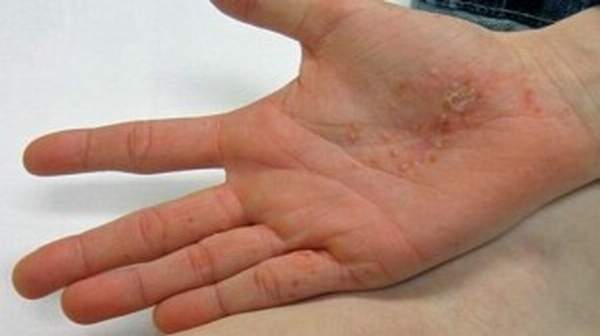What's in this article?
 What is Dyshidrotic Eczema
What is Dyshidrotic Eczema
Dyshidrotic eczema, or dyshidrosis, is a skin condition in which blisters develop on the soles of your feet and/or the palms of your hands. The blisters are usually itchy and may be filled with fluid. Blisters normally last for about three weeks and may be related to seasonal allergies or stress.
Dyshidrotic eczema is a condition in which small blisters develop on the hands and feet. Blisters are often itchy.
Causes
This blistering type of eczema is twice as common in women than men.
People are more likely to develop dyshidrotic eczema when:
- They are under stress
- They have allergies, such as hayfever
- Their hands are often in water or moist
- They do cement work or other work that exposes their hands to chromium, cobalt, nickel
- The cause is unknown. The condition seems to appear during certain times of the year.
Symptoms
Small fluid-filled blisters called vesicles appear on the fingers, hands, and feet. They are most common along the edges of the fingers, toes, palms, and soles. These blisters can be very itchy. They also cause scaly patches of skin that flake or get red, cracked, and painful.
Scratching leads to skin changes and skin thickening. Large blisters may cause pain.
How Do I Know If I Have Dyshidrotic Eczema?
If you have dyshidrotic eczema, you will notice blisters forming on your fingers, toes, hands, and/or feet. The blisters may be more common on the edges of these areas and will probably be full of fluid. Sometimes, large blisters will form, which can be particularly painful. Usually, the blisters will be very itchy and may cause your skin to flake. Some patients report that the affected areas become cracked and are painful to the touch.
The blisters may last for up to three weeks before they begin to dry. As the blisters dry up, they will turn into skin cracks that may be painful. If you have been scratching the affected areas, you may also notice that your skin seems thicker or feels spongy.
Treatment
Scratching only the condition worse.
- Anti-itch medicines taken by mouth, such as diphenhydramine (Benadryl) and loratiadine (such as Claritin), may help you stop scratching.
- Take an anti-itch medicine before bed if you scratch in your sleep.
- Apply an ointments or creams to your hands at least two times per day, and after every hand washing.
- Heavy ointments are best. Petroleum jelly (such as Vaseline), mineral oil or vegetable shortening may be best but can be messy.
- Creams are thicker than lotions. Creams such as Eucerin and Lubriderm may be helpful.
Your doctor may prescribe steroid (or corticosteroid) ointments or creams. Other creams or ointments such as tacrolimus or pimecrolimus may also be used.
Your doctor may recommend the following if your symptoms are very bad:
- Steroid pills
- Coal tar preparations
- Phototherapy (ultraviolet light therapy)
Avoid frequent bathing, hand washing, and irritating substances, which can make itching worse.
How Is Dyshidrotic Eczema Diagnosed?
In many cases, your doctor will be able to diagnose dyshidrotic eczema by examining your skin carefully. As the symptoms of dyshidrotic eczema can be similar to those of other skin conditions, your doctor may choose to run certain tests. The tests may include a skin biopsy, which involves removing a small patch of skin for lab testing. The biopsy can rule out other possible causes of your blisters, such as a fungal infection.
If your doctor believes that your outbreak of dyshidrotic eczema is directly related to allergies, allergy skin testing may also be ordered.





